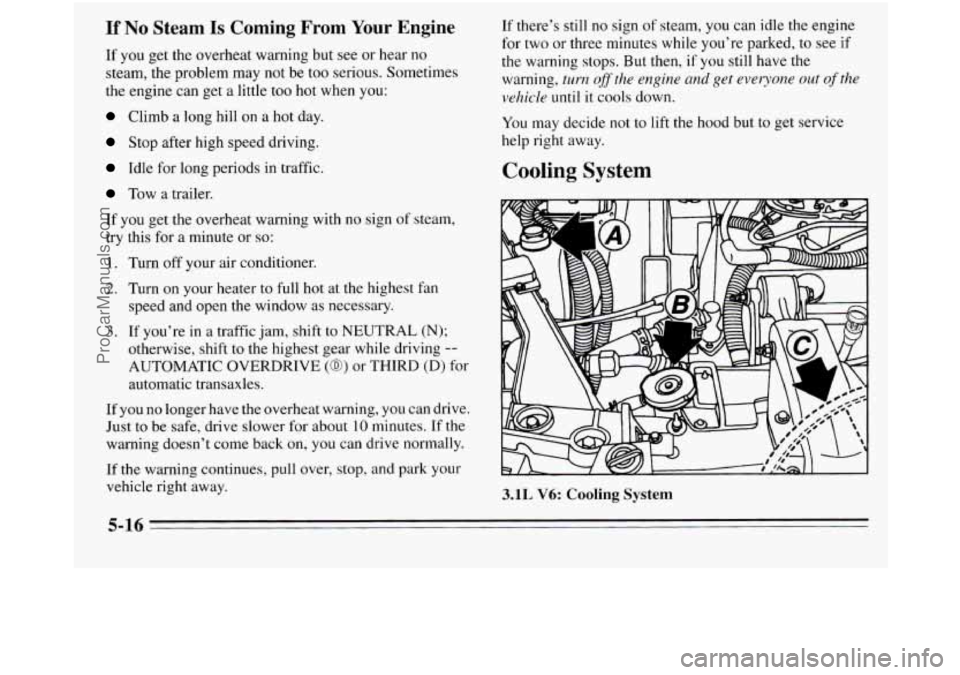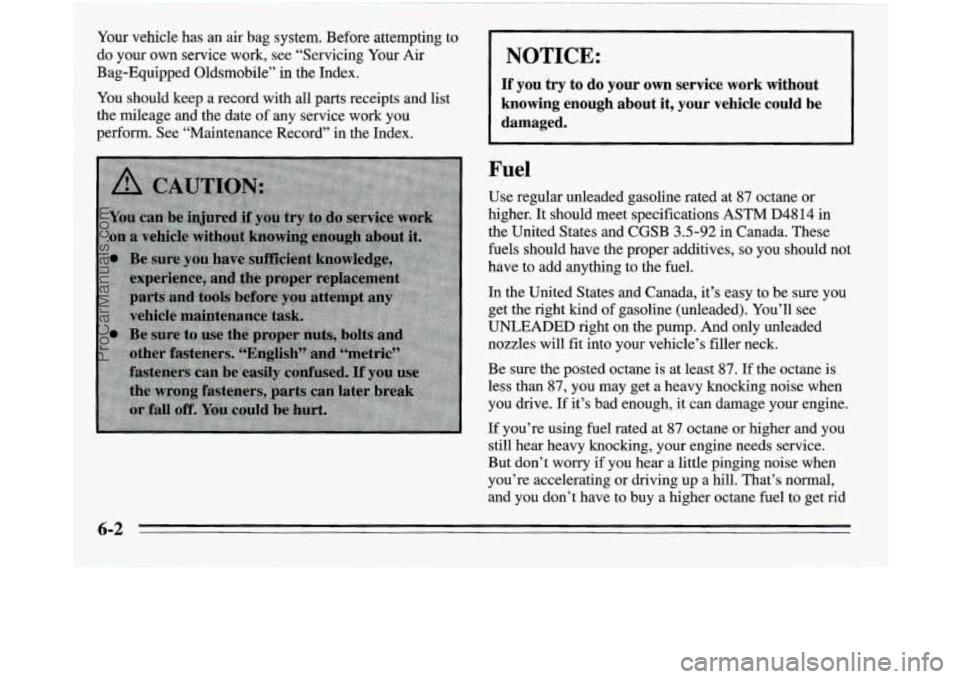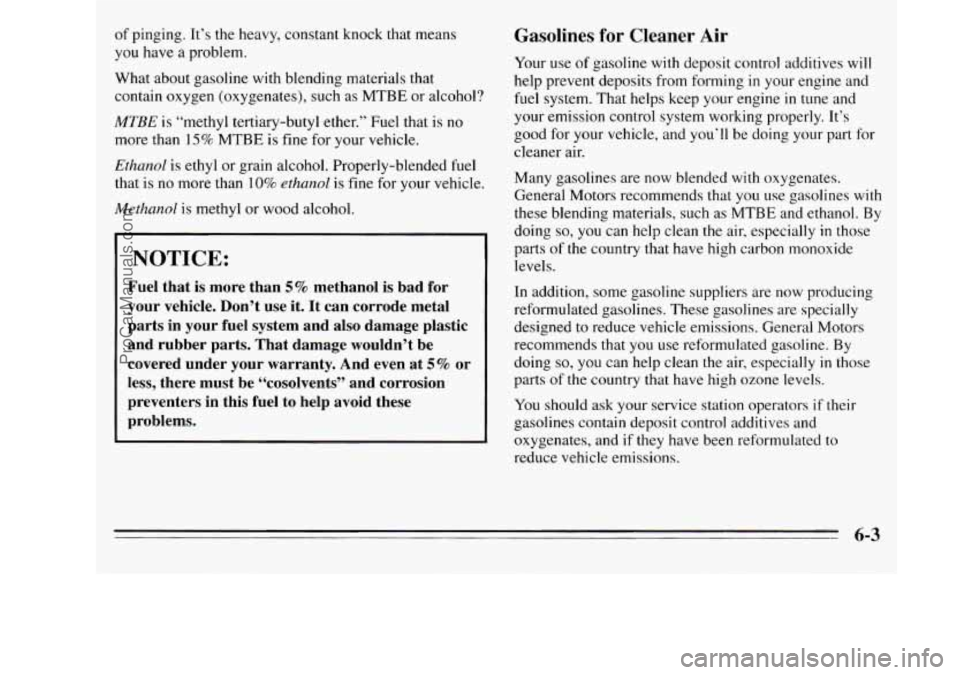Page 230 of 390
Towing Your Vehicle
J
I
Try to have a GM dealer or a professional towing
service tow your vehicle. The usual towing
equipment
is:
(A) Sling-type tow truck
(B) Wheel-lift tow truck
(C) Car carrier
If your vehicle has been changed or modified since it
was factory-new by adding aftermarket items like fog
lamps, aero skirting, or special tires and wheels, these
instructions and illustrations may not be correct.
Before you do anything, turn
on the hazard warning
flashers.
5-8
ProCarManuals.com
Page 231 of 390
When you call, tell the towing service:
0 That your vehicle cannot be towed from the front
0 That your vehicle has front-wheel drive.
0 The make, model, and year of your vehicle.
0 Whether you can still move the shift lever.
with
sling-type equipment.
0 If there was an accident, what was damaged.
When the towing service arrives, let the tow operator
know that this manual contains detailed towing
instructions and illustrations. The operator may want to
see them.
5-9
ProCarManuals.com
Page 232 of 390
When your vehicle is being towed, have the key in the
ignition
in the OFF position. The steering wheel should
be clamped in a straight-ahead position, with a clamping
device designed for towing service.
Do not use the
vehicle’s steering column lock for this. The transaxle
should be in
NEUTRAL (N) and the parking brake
released.
Don’t have your vehicle towed on the front wheels,
unless you must.
If the vehicle must be towed on the
front wheels, don’t go more than
35 mph (56 km/h) or
farther than 50 miles (80 km) or your transaxle will be
damaged. If these limits must be exceeded, then the
front wheels have to be supported on a dolly.
5-10
ProCarManuals.com
Page 238 of 390

If No Steam Is Coming From Your Engine
If you get the overheat warning but see or hear no
steam, the problem may not be too serious. Sometimes
the engine can get
a little too hot when you:
Climb a long hill on a hot day.
Stop after high speed driving.
Idle for long periods in traffic.
Tow a trailer.
If you get the overheat warning with no sign
of steam,
try this for a minute or
so:
1. Turn off your air conditioner.
2. Turn on your heater to full hot at the highest fan
speed and open the window as necessary.
3. If you’re in a traffic jam, shift to NEUTRAL (N);
otherwise, shift to the highest gear while driving --
AUTOMATIC OVERDRIVE (a) or THIRD (D) for
automatic transaxles.
If you no longer have the overheat warning, you can drive.
Just to be safe, drive slower for about
10 minutes. If the
warning doesn’t come back on, you can drive normally.
If the warning continues, pull over, stop, and park your
vehicle right away.
If there’s still no sign of steam, you can idle the engine
for two or three minutes while you’re parked, to see if
the warning stops. But then, if you still have the
warning,
turn off the engine and get everyone out of the
vehicle
until it cools down.
You may decide not to lift the hood but to get service
help right away.
Cooling System
3.1L V6: Cooling System
5-16
ProCarManuals.com
Page 240 of 390
3800 V6: Recovery Tank Level
l I I
The coolant level should be at or above the FULL HOT
mark. If it isn’t, you may have a leak in the radiator
hoses, heater hoses, radiator, water pump or somewhere
else in the cooling system.
I NOTICE:
Engine damage from running your engine
without coolant isn’t covered by your warranty.
If there seems to be no leak, with the engine on, check to
see if the electric engine fan is running.
If the engine is
overheating, the fan should be running.
If it isn’t, your
vehicle needs service.
5-18
ProCarManuals.com
Page 261 of 390
bectlon 6 -Service and Appearance Care
Here you will find information about the care of your
Oldsmobile. This section begins with service and fuel
information, and then it shows how to check important
fluid and lubricant levels. There is also technical
information about your vehicle, and a part devoted to its
appearance care.
Service
Your Oldsmobile retailer knows your vehicle best and
wants you to be happy with it. We hope you’ll go to
your retailer for all your service needs. You’ll get
genuine GM parts and GM-trained and supported
service people. We
hope
you’ll want to keep your GM vehicle all GM.
Genuine GM parts have one of these marks:
IGM
Doing Your Own Service Work
If you want to do some of your own service work, you’ll
want
to get the proper Oldsmobile Service Manual. It
tells you much more about how to service your
Oldsmobile than this manual can.
To order the proper
service manual, see “Service Publications” in the Index.
6-1
ProCarManuals.com
Page 262 of 390

Your vehicle has an air bag system. Before attempting to
do your own service work, see “Servicing Your Air
Bag-Equipped Oldsmobile”
in the Index.
You should keep a record with all parts receipts and list
the mileage and the date of any service work you
perform. See “Maintenance Record” in the Index.
~~ ~~~~~ ~~ ~
NOTICE:
If you try to do your own service work without
knowing enough about it,
your vehicle could be
I damaged. I
Fuel
Use regular unleaded gasoline rated at 87 octane or
higher. It should meet specifications ASTM D4814 in
the United States and CGSB
3.5-92 in Canada. These
fuels should have the proper additives, so you should not
have to add anything to the fuel.
In the United States and Canada, it’s easy to be sure you
get the right kind of gasoline (unleaded). You’ll see
UNLEADED right on the pump. And only unleaded
nozzles will fit into your vehicle’s filler neck.
Be sure the posted octane is at least
87, If the octane is
less than
87, you may get a heavy knocking noise when
you drive. If it’s bad enough, it can damage your engine.
If you’re using fuel rated at
87 octane or higher and you
still hear heavy knocking, your engine needs service.
But don’t worry if you hear a little pinging noise when
you’re accelerating or driving up a hill. That’s normal,
and you don’t have to buy a higher octane fuel to get rid
6-2
ProCarManuals.com
Page 263 of 390

of pinging. It’s the heavy, constant knock that means
you have
a problem.
What about gasoline with blending materials that
contain oxygen (oxygenates), such as
MTBE or alcohol?
MTBE is “methyl tertiary-butyl ether.” Fuel that is no
more than
15% MTBE is fine for your vehicle.
Ethanol is ethyl or grain alcohol. Properly-blended fuel
that is
no more than 10% ethanol is fine for your vehicle.
Methanol is methyl or wood alcohol.
I NOTICE:
Fuel that is more than 5% methanol is bad for
your vehicle. Don’t use it. It can corrode metal
parts in your fuel system and also damage plastic
and rubber parts. That damage wouldn’t be
covered under your warranty. And even at
5% or
less, there must be “cosolvents” and corrosion
preventers in this fuel to help avoid these
problems.
Gasolines for Cleaner Air
Your use of gasoline with deposit control additives will
help prevent deposits from forming
in your engine and
fuel system. That helps keep your engine
in tune and
your emission control system working properly. It’s
good for your vehicle, and you’ll be doing your
part for
cleaner air.
Many gasolines are now blended with oxygenates.
General Motors recommends that you use gasolines with
these blending materials, such as
MTBE and ethanol. By
doing
so, you can help clean the air, especially in those
parts of the country that have high carbon monoxide
levels.
In addition, some gasoline suppliers are now producing
reformulated gasolines. These gasolines are specially
designed to reduce vehicle emissions. General Motors
recommends that you use reformulated gasoline.
By
doing so, you can help clean the air, especially in those
parts of the country that have high ozone levels.
You should ask your service station operators
if their
gasolines contain deposit control additives and
oxygenates, and if they have been reformulated to
reduce vehicle emissions.
6-3
ProCarManuals.com